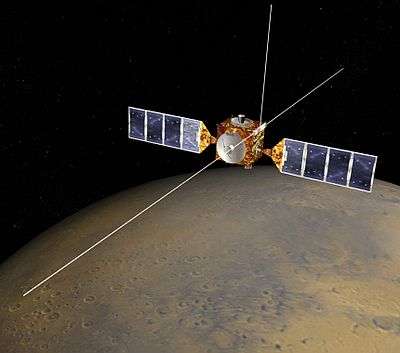High Resolution Stereo Camera
High Resolution Stereo Camera (HRSC) is a camera experiment on Mars Express.[1] A version for Earth called HRSC-AX was also developed, as was a version for Mars 96.[1] It has four main parts: camera head, super resolution channel, instrument frame, and digital unit.[1] At an altitude of 250 km from Mars, SRC can produce images with a resolution of 2.3 meters/pixel of 2.35 km square Mars terrain.[1] It has 9 other channels and can produce digital terrain models.[1] A typical image from HRSC of Mars has a resolution ranging from 12.5 for nadir (directly down) to 25 m/pixel for the farthest off-nadir shots, which can be up to 18.9 degrees.[2]
By 2012, about 61.5% of the surface of Mars was mapped at a resolution of at least 20 meters per pixel by the Mars Express mission using this camera.[3] Another area of study is repeat imaging, to allow the study of dynamic processes on Mars.[2][4] Another trick is to make short videos of the Mars surface by taking advantage of the pushbroom nature of the detector, each section is slightly offset for a different color, but when combined each view be used to make a short animation.[5]
By the start of 2015, about 70% of Mars had been imaged by Mars at resolutions greater than 20 m per pixel, and 97% at resolutions of least 60 m per pixel.[6]
Example observation
Here is Orcus Patera, imaged by the HRSC:


See also
- Trace Gas Orbiter (next ESA Mars orbiter, arrived 2016)
References
- DLR - HRSC on Mars Express Archived 2012-01-17 at the Wayback Machine
- "High-resolution repeat imaging allows detecting dynamic surface processes on Mars".
- ESA -Mapping Mars
- Sidiropoulos, P.; Muller, J.-P. (2015). "On the status of orbital high-resolution repeat imaging of Mars for the observation of dynamic surface processes" (PDF). Planetary and Space Science. 117: 207–222. Bibcode:2015P&SS..117..207S. doi:10.1016/j.pss.2015.06.017.
- TPS - Capturing Martian Weather in Motion - November 4, 2016
- THE HIGH RESOLUTION STEREO CAMERA (HRSC): STATUS AND FACTS (2015)
External links
| Wikimedia Commons has media related to High Resolution Stereo Camera (HRSC). |
- ESA - High Resolution Stereo Camera
- Aeolis Mons (Mt. Sharp) and Gale - Image/HRSCview
- Aeolis Mons (Mt. Sharp) - HRSCview (oblique view looking east)
- HRSC + Phobos (with SRC shots overlaid)
- HRSC Press release archive (2004-2012)
- HRSC with SRC of Victoria Crater and area near Opportunity rover's landing site
- Clouds in Nilokeras Scopulus
- TPS - Capturing Martian Weather in Motion - November 4, 2016
- THE HIGH RESOLUTION STEREO CAMERA (HRSC): STATUS AND FACTS (2015) (Includes graph of cumulative surface coverage by resolution, up to 2015)
